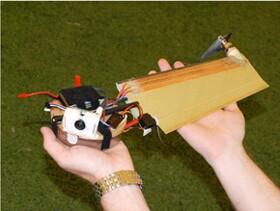If you've ever watched a maple seed spiraling down from a branch, you may have marveled at how it looked like a tiny one-rotor-bladed helicopter. If you did, well, you weren't the only one. In 2009, students from the University of Maryland's Clark School of Engineering unveiled their remarkable samara (maple seed)-inspired micro air vehicle, which was billed as "the world's first controllable robotic samara monocopter." Flash forward to this Tuesday, and Lockheed Martin performed the first public flight of its similar Samarai Flyer, at the Association for Unmanned Vehicle Systems International conference in Washington, D.C.
In development as part of DARPA's Nano Air Vehicle program since 2006, the Samarai Flyer consists of a disc-like unit that contains its battery and electronics, joined to a single wing with a propeller mounted at the far end - the original design actually called for a fuel-powered miniature jet thruster, which may still be the plan for the final version. When in flight, the whole aircraft spins around in a circle, with the disc at the center. A remotely-adjustable trailing-edge wing flap allows users to steer it.
The Samarai can take off from and land on the ground, or be launched by being thrown into the air like a boomerang. It is 16 inches (40.6 cm) long, weighs less than half a pound (around 227 grams) and only has two moving parts, so it lends itself to being stuffed in a backpack, then pulled out for use.

Unlike the U Maryland flyer, it even has an onboard video camera that transmits a live feed to the operator. Because that camera (which is mounted on the disc) is constantly turning around, it doesn't obtain video in a normal fashion. Instead, it captures one frame at the same point in every rotation, those frames combining into one continuous relatively steady shot. By varying the point in the rotation at which the frames are grabbed, users can virtually "pan" the camera 360 degrees. Plans call for the disc to ultimately incorporate a sensor that would capture four frames per rotation, each at the same point.
Because its design is so robust and efficient, the Samarai is intended mainly for military surveillance and reconnaissance missions. It is capable of carrying and dropping small payloads, and can be inexpensively fabricated using a 3D printer - this also means that it would relatively simple to produce custom-designed Flyers for specific purposes.
The aircraft's first public flight can be seen in the video below.







